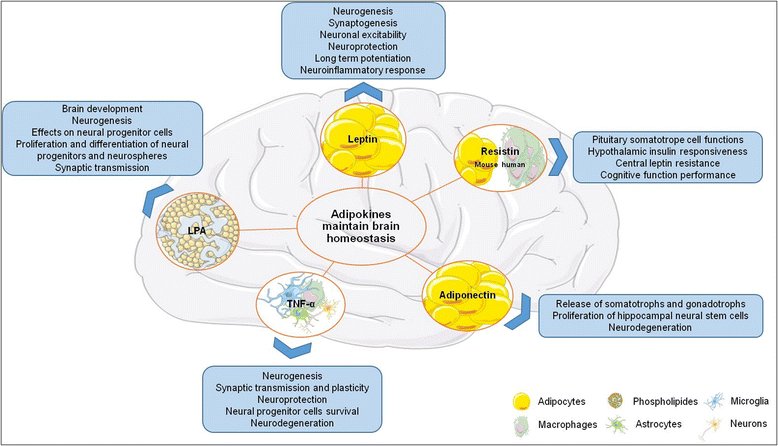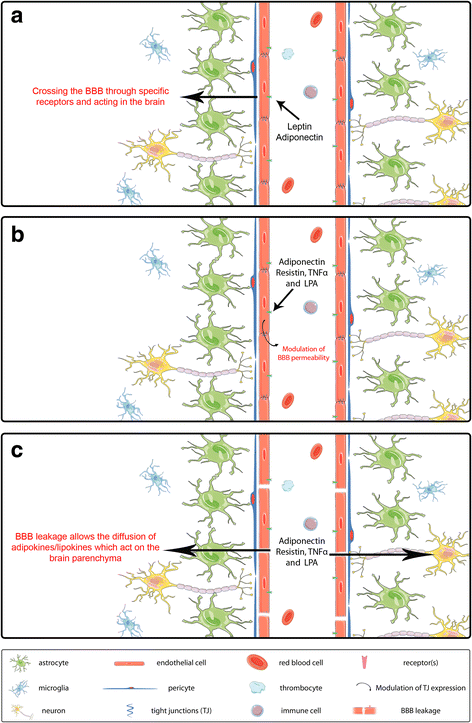Secret talk between adipose tissue and central nervous system via secreted factors-an emerging frontier in the neurodegenerative research
- PMID: 27012931
- PMCID: PMC4806498
- DOI: 10.1186/s12974-016-0530-x
Secret talk between adipose tissue and central nervous system via secreted factors-an emerging frontier in the neurodegenerative research
Abstract
First seen as a storage organ, the white adipose tissue (WAT) is now considered as an endocrine organ. WAT can produce an array of bioactive factors known as adipokines acting at physiological level and playing a vital role in energy metabolism as well as in immune response. The global effect of adipokines in metabolic activities is well established, but their impact on the physiology and the pathophysiology of the central nervous system (CNS) remains poorly defined. Adipokines are not only produced by the WAT but can also be expressed in the CNS where receptors for these factors are present. When produced in periphery and to affect the CNS, these factors may either cross the blood brain barrier (BBB) or modify the BBB physiology by acting on cells forming the BBB. Adipokines could regulate neuroinflammation and oxidative stress which are two major physiological processes involved in neurodegeneration and are associated with many chronic neurodegenerative diseases. In this review, we focus on four important adipokines (leptin, resistin, adiponectin, and TNFα) and one lipokine (lysophosphatidic acid-LPA) associated with autotaxin, its producing enzyme. Their potential effects on neurodegeneration and brain repair (neurogenesis) will be discussed. Understanding and regulating these adipokines could be an interesting lead to novel therapeutic strategy in order to counteract neurodegenerative disorders and/or promote brain repair.
Keywords: Adipocytokines; Central nervous system; Diabetes; Neurodegeneration; Neurogenesis; Neuroinflammation; Obesity; White adipose tissue.
Figures


References
-
- Awada R, Parimisetty A, Lefebvre d’Hellencourt C. Influence of obesity on neurodegenerative diseases. Neurodegener Dis. 2013;Chapter 16:381–401.
-
- World Health Organisation W: obesity and overweight. http://www.who.int/mediacentre/factsheets/fs311/en/. Accessed 22 Mar 2016.
-
- World Health Organisation W: diabetes. http://www.who.int/mediacentre/factsheets/fs312/en/. Accessed 22 Mar 2016.
-
- Alberti KG, Zimmet PZ. Definition, diagnosis and classification of diabetes mellitus and its complications. Part 1: diagnosis and classification of diabetes mellitus provisional report of a WHO consultation. Diabet Med. 1998;15:539–53. doi: 10.1002/(SICI)1096-9136(199807)15:7<539::AID-DIA668>3.0.CO;2-S. - DOI - PubMed
-
- Roglic G, Unwin N, Bennett PH, Mathers C, Tuomilehto J, Nag S, et al. The burden of mortality attributable to diabetes: realistic estimates for the year 2000. Diabetes Care. 2005;28:2130–5. - PubMed
Publication types
MeSH terms
LinkOut - more resources
Full Text Sources
Other Literature Sources
Medical
Miscellaneous

